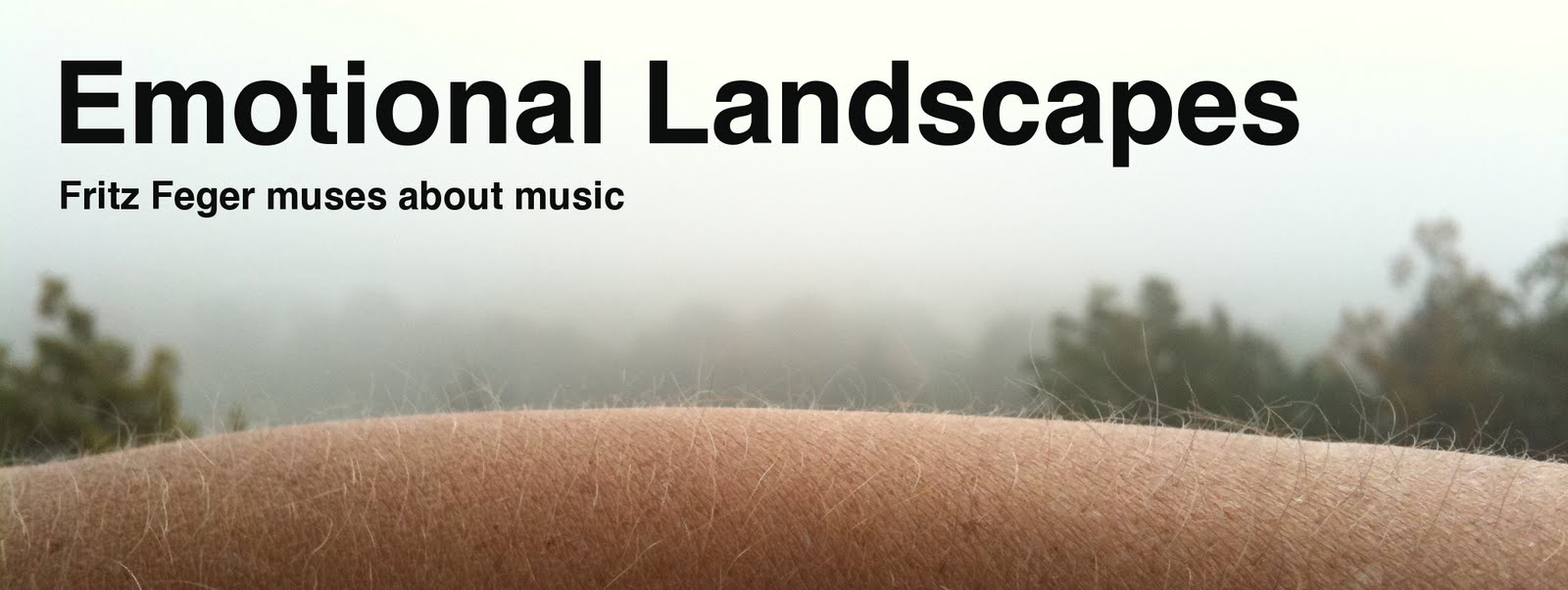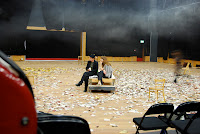A pre-premier of this film is scheduled for December 8, 2010 at Metropolis-Kino Hamburg. The soundtrack begins to take shape. Which shape and why will be a future subject of this blog. However, a core piece of music leads over to the topic "space for music" right away: it plays along a voice-over.
What is a voice-over? Contrary to an off-text, i. e. an audible text of a figure who features on scene but is out of sight (for the moment), a voice-over is a narrated text that comes from another time and space, so to say. In off-text one could, in contrast to voice-over, in theory display the speaker by adjusting the camera's position in the picture's story space. A voice-over can nevertheless be spoken by a figure who is part of the plot - but without watching her or him speaking, even if on screen. This is exactly what happens in Schattenlinie: two closemouthed characters are on the road in St. Pauli for several minutes, while their thoughs are told by their respective voices. This epic moment is a typical function of the voice-over technique.Insofar as voice-over (who has heard this on stage, and where? Please comment!) strongly relies on the specific possibilities of sound mix in film - intimate voice-over against fully orchestrated music an street or subway noise -, there could be no sharper contrast to the conditions of the Düsseldorf Möwe production. The rehearsal stage C2 at Central in der alten Paketpost, serving as main stage during the renovation of the regular stage, is a slightly over-acoustic vast room. It remains empty in Möwe, accept some chairs, a low footbridge, some foliage and a curtain.
Director Amélie Niermeyer leaves everybody on stage throughout. Apart from a couple of turbulent moments, the figures converse in a moderate, well-nigh "realistic" temperature, given today's state of affairs in theatre. Her focus on dialog (by the way, Cechov is brillant! An exhilarating read!) and on driving the story literally tolerates interruptions between the acts only, when backfitting is inavoidable. Moments without dialog bear tense silence. There are three "special situations" where there is music under the scene, namely the theatre performance in the middle of act I., the beginning of act II. / Boule game, as well as the beginning of act III. / good bye party.
In short: first, the project to put, apart from those three moments, only the faintest Cello dots under the scene finally had to be abandoned for forlorness. Annoying. Secondly, the rigid limitation in space for music only allowed for fragmentary an low-key concoctions, at least this is what I was able to achieve. Therefore, I do not see why I should receive these as music in its own right, and record them and put online, or so. This is just too little.
The (however well audible) pieces of music between the acts are only three in number, last only a couple of seconds each, and are, following hours-long minimalism, accompanied by frantic actors, curtain, light shift, props and a stage rotating speed all of a sudden. Things which distract attention from the music. Two out of those three exceptional moments mentioned above are bound to repetition and monotony for scenic reasons, and subject to the actors need to "put their words all delicate" in order to get their attitude right. Solely remains the theater performance halfway through the first act. Might be we shoot a video of that one...
To make it complete, there is one more thing the severity of which has been clear in my mind since a long time, but has not been covered in the technique-focused March Space for Music posting: inside the branch Big Houses of Contemporary Theatre, on average (!), music ranks quite low concerning experience and - correspondingly? - regard. The shares, ranging from the average theatre rehearsal over the house's expenses to sentences per press critique, even how long one has the floor at the after-rehearsal pub meeting, are constant: 40% director, 40% actors (star roles 35%, supporting roles 5%), stage and costume design 15%, the rest music, if one is lucky. Apart from individual deviations which can, as always, be substantial, these shares only change by any kind of star status (only culture/entertainment really counts) or personal juice.
For daily work this means that, given a standard two months production period, not even a single hour of regular rehearsal time is sacrified for checking out music. Then, actors would be spear carriers of music; then, work on scene x would not be pushed on. On the other hand, it is absolutely common that music serves as spear carrier of acting, because it is of course impossible to retrieve or develop the right attitude without the music played in earlier rehearsals. In addition, the musical director has to close-mesh follow what is going on on rehearsal in order to be able to react to new requirements at short notice and well-informed. As a result, attendance is generally required, be it to fill the rehearsal stage with sound, be it in order not to miss a thing. Yet it is awkward to work on music during rehearsal. Soundcheck begins at 10.30 p.m., past the lighting rehearsal. "Space for music".
What I have thus said is of course not valid for every production I have luckily been part of - on the contrary, to name only a few, there was luxuriosly large space for music in Inferno/Purgatorio/Paradiso at Thalia Theater 2001/2002, directed by Tomasz Pandur, including the rehearsals. Likewise, all children theatre productions were different in that respect. But I could have made exactly the same points on the Volksfeind production earlier this year, with the only difference that I have been recording plenty of music "in its own right" for it - which however appears in the performance only briefly.
Leaving aside my obvious deficiency to cope with such conditions and just function, I can hear a leitmotif. To say it with (German seventies comedian) Otto Waalkes: In The Seagull my shirt is mouse gray in the first half, whilst in the second half it sports a light dash of ash. Curtain.







